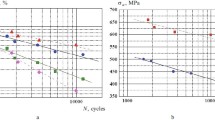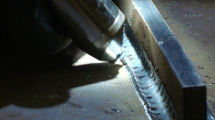Abstract
The fatigue crack propagation rate and the fatigue threshold were investigated for transverse-butt-welded joints of the austenitic stainless steel SUS304. Specimens were of the center-cracked type. In three sets of tests the fatigue crack passed through the weld metal, and in the other two sets, through the base metal. The fatigue crack propagation properties coincided with each other at different stress ratios for the weld metal, and at the higher stress ratios for the base metal. The propagation properties improved at the stress ratio of zero for the base metal. The absence of a stress ratio effect means that the coincided properties are basic ones in which fatigue crack closure does not occur. However, fractographic appearance and surface roughness were quite different between weld metal and base metal. The coincidence of fatigue crack propagation properties in spite of the difference in fractographic features reveals that the fractographic appearance and surface roughness only have a minor effect on basic fatigue crack propagation behaviour.
Similar content being viewed by others
References
A. Ohta, E. Sasaki, M. Nihei, M. Kosuge, M. Kanao and M. Inagaki, International Journal of Fatigue 4 (1982) 233–237.
W. Elber, ASTM STP 486 (1971) 230–242.
A. Ohta, E. Sasaki, M. Kamakura, M. Nihei, M. Kosuge, M. Kanao and M. Inagaki, Transactions Japan Welding Society 12 (1981) 31–38.
A. Ohta, I. Soya, S. Nishijima and M. Kosuge, Engineering Fracture Mechanics 24 (1986) 789–802.
R.O. Ritchie, Transactions ASME Journal of Engineering Materials and Technology 99 (1977) 195–204.
H. Kobayasi, H. Tsuji, K.D. Park and H. Nakazawa, Transactions Japan Society Mechanical Engineer 50–453A (1986) 1003–1010 (in Japanese).
K. Asami, Current Research on Fatigue Cracks, Elsevier Applied Science (1987) 201–228.
A. J. McEvily and K. Minakawa, Fatigue Crack Growth Threshold Concepts, ASME (1983) 517–530.
C. Masuda, H. Sumiyoshi, M. Kosuge, A. Ohta and S. Nishijima, International Journal of Fatigue 9 (1987) 233–237.
S. Matsuoka, E. Takeuchi, M. Kosuge, M. Shimodaira, A. Ohta and S. Nishijima, Journal of Testing and Evaluation 14 (1986) 312–317.
A. Ohta, M. Kosuge and S. Nishijima, Journal of Pressure Vessels & Piping 33 (1988) 251–268.
Author information
Authors and Affiliations
Rights and permissions
About this article
Cite this article
Suzuki, N., Mawari, T. & Ohta, A. Minor role of fractographic features in basic fatigue crack propagation properties. Int J Fract 54, 131–138 (1992). https://doi.org/10.1007/BF00028915
Received:
Accepted:
Issue Date:
DOI: https://doi.org/10.1007/BF00028915




